|
Hasegawa 1/48 F/A-18E Super Hornet |
|
|
Kit Number 07239 |
|
|
Reviewed By James Kelley, #42106 |
|
|
|
|
|
MSRP: $64.99 USD The Machine: Introduction from the Boeing Technical Document “Precision Engagement and Mobility Global Strike: F/A-18E/F Super Hornet Backgrounder.” The combat-proven F/A-18E/F Super Hornet is the most advanced multi-role strike fighter available today or for the foreseeable future. The Super Hornet is equipped with all the capability, flexibility and performance necessary to modernize the air or naval aviation forces of any country. Built by the industry team of Boeing, Northrop Grumman, GE Aircraft Engines, Raytheon and more than 1,800 suppliers nationwide, the Super Hornet provides the war fighter with today’s newest advances in multi-mission capability and growth for decades to come in missions, roles, and technology. The Super Hornet’s suite of integrated and networked systems provides enhanced interoperability and support for ground forces as well as the overall force commander. The Super Hornet entered combat on its maiden voyage in 2002 and remains combat deployed in the global war on terrorism. Two versions of the Super Hornet – the single-seat E model and the two-seat F model –are in production today and in service with the U.S. Navy. The first production model Super Hornet was delivered to the U.S. Navy in December 1998, more than a month ahead of schedule. To date the program is three months ahead of delivery schedule. After completing the most thorough operational evaluation in U.S. Naval history, the F/A-18E/F Super Hornet entered operational service in November 1999 and the program was awarded an unprecedented five-year multiyear contract for 211 aircraft. The first operational F/A-18E/F Super Hornet squadron – VFA-115 – stood up in June 2001 and deployed aboard the USS Abraham Lincoln (CVN 72) in July 2002. The program delivered the 200th Super Hornet to the U.S. Navy in August 2004. In April 2005, Boeing delivered the first Block II Super Hornet, complete with AESA radar. Both are true multi-role aircraft, able to perform virtually every mission in the tactical spectrum including air superiority, day/night strike with precision-guided weapons, fighter escort, close air support, suppression of enemy air defense, maritime strike, reconnaissance, forward air control and tanker. With a total of 11 weapon stations, the Super Hornet also provides war fighters with extraordinary payload flexibility by carrying a mixed load of air-to-air and air-to-ground ordnance. A typical basic load out for a self-escort strike mission starts with an advanced infrared targeting pod, one AIM-120 “AMRAAM,” two AIM-9 “Sidewinder” missiles, and an external fuel tank. This leaves six under wing weapon stations available to carry a variety of weapons and other stores. A comprehensive spiral development design concept – including the addition of the APG-79 active electronically scanned array (AESA) radar – offers continuously improving overall mission capability and supportability. Other recently incorporated upgrades include an advanced targeting forward looking infrared (ATFLIR), joint-helmet mounted cueing system (JHMCS), multifunctional information distribution system (MIDS), and an advanced aft crew station. Fifth generation aerodynamic design gives the F/A-18E/F exceptional combat maneuverability, an unlimited angle of attack, high resistance to spins and departures and ease of handling and training. Its reconfigurable digital flight control system can detect damage to or full loss of a flight control and still allow safe recovery. These and other enhancements will ensure that the Super Hornet remains combat relevant well into the 21st century. Two General Electric F414-GE-400 engines power the Super Hornet, producing a combined 44,000 pounds of thrust. The F414’s light yet robust design yields a 9:1 thrust to-weight ratio, one of the highest of any modern fighter engine. Increased airflow to the engine is provided through the Super Hornet’s large, distinctively shaped inlets. A full authority digital electronics control (FADEC) allows for unrestricted engine response in any phase of flight. The Model: As Hasegawa recently released the F/A-18F Super Hornet this kitted variant, with the exception of part A3 (extended to conceal the “backseat”) is exactly the same, parts-wise. I will, therefore, spare you the requisite “Sprue Shots” of all of the kit’s parts trees, and instead refer you to Bart Cusumano’s review of the F-18F kit if you’d like to see the parts. Having said that, there are a few small differences between what’s in the box. The F-18F kit’s initial production run came with a very nicely done reference monograph, consisting of eight A-4 sized pages. Not so with the “Echo” variant. The instruction booklets are essentially the same, excepting for the paint/decal guides at the end. The double-tubbed cockpit from the “Foxtrot” kit is the same, as is the pair of “R” parts trees. This means you get 2 air crewmen, which will help bolster your spare parts box. Both figures, as with the previous release, have the option of either the older-style helmet or the new JHMCS helmets used in conjunction with the Advanced Crew Station (ACS) cockpits. This is more of an issue with the two-seat variant, as a single seat fighter won’t have two crew to function in a “decoupled” manner, but you are still provided the option should you choose to man your aircraft. The brightly-colored, extensive decal sheet provides two options; either a Hi-Viz scheme for the Royal Maces (VFA-27), based out of Lemoore, CA. or a Lo-Viz scheme for the Eagles (VFA-115) also out of Lemoore. The decals were not too thick, responded well to Micro-Set/Sol, and include an abundance of stencils. Also included are helmet squadron colors, a nice touch. One criticism I have is that of the instrument panel decal. You have the option of painting or decaling the panel, but the decal is all black with white outlines representing the CRT screens. Now, if the aircraft is unmanned, it’ll be powered down, along with the avionics. So, the screens would be dark. But the decal is too cheesy to represent even that. I had an unused decal from an earlier build of Revell’s F/A-18E offering, and used it. It represents a powered-up machine, but I don’t care… it adds significantly to the overall appearance. Decals for the ejection seat data plates are on this sheet as well, which were absent from the two-seat version. The cockpit itself is a bit sparse, but not unusable. The details are raised, and include both side-panels. The seat appears to be fairly accurate in shape and general detail, but is devoid of any fine points. No harness is included, molded-on or otherwise. If you choose to leave the pilot out, you’ll need to make a harness or acquire an aftermarket set. Overall construction, as one would expect from Hasegawa, is relatively simple and without drama. The engraved detail throughout is crisp and fine, and no major seam cleanup was required. The option for folded wings is provided here, as with the earlier kit, and requires some easy, minor cutting. The provided diagram makes it even easier. Unlike the Revell kit, Hasegawa’s Super Hornets have deep, fairly accurate intake trunkings. What does this mean? The Revell kit’s were “shallow”, placing the compressor blades much too far forward, giving an awkward appearance. Hasegawa’s are much further back, more accurately depicting the actual power plants. Nicely detailed, they make a good match for the exhaust face and afterburner cans. Some aftermarket cans would dress up the model even more, but the kit’s look ok as is. Some careful assembly and patience expended here will reap a big dividend later. The kit’s intake mouths are engineered such that they fit almost perfectly, and result in a very nice compressor pathway that won’t need a FOD cover. And, the thin seam between the “exterior” intake lip and the start of the “internal” trunking is a true demarcation on the real aircraft. It’s replicated convincingly here. Another option you have is to portray the flaps and ailerons in either the “Up” or “Down” positions. Enough actuators and hinges are provided for either option, and no surgery is required. I like this a lot, as any time there’s an opportunity to fold or drop something, I’m in! The model is a bit more “animated” this way, I think, and appeals more to the eye. The landing gear assembles easily, although cleanup of a small molding seam is required for all three sets of gear. The mounting mechanism is engineered to reproduce the correct stance, and they have details which beg for an oil wash. The gear bays are even more accurately detailed, and you can have a field day dry brushing in them. Depth appears correct as well. Although I didn’t measure them (or anything else) I have seen some models which have shallow-appearing gear wells. The clear pieces are nicely molded, except for the seemingly-requisite, sagittal seam down the canopy’s middle. After lightly scraping it with the blade edge of a new #11 scalpel blade, it’s easily removed. Buff it out with Micromesh pads grades 1500-4000, then polish it with the finishing compound Micromesh provides in their pad kits, and it’s ready for a dip into the Future. A crystal-clear canopy is that easy! As with many of Hasegawa’s “modern” kits (jets) the ordinance provided is light. Aside from an ATFLIR pod (not very detailed) you get a pair each of AIM-120 AMRAAM and AIM-9X Sidewinder missiles, along with 4 auxiliary fuel tanks. Barely enough for a self-escort mission (But’cha got no bombs man, where ya goin!?) I added a trio of GBU-16 Paveway IIs and a triple-ejector rack (TER) from the Hasegawa Aircraft Weapons Set “D”. These sets are exactly why Hasegawa doesn’t put much ordinance in the kits but we already knew that. This is a wonderful model kit, again exactly like it’s “Foxtrot” counterpart. It’s accurate, very nicely detailed overall, and easy to build. There are no real fit issues. A beginner with a few projects to his or her credit would do well to use this kit as a step up to the next level, and you experts out there could make a masterpiece with a little extra work. Of course I highly recommend this kit, and I plan to obtain at least one more of each variant for myself. My thanks and appreciation go to John Noack, 1st VP, IPMS/USA, and the fine people at Hasegawa and Dragon Models USA for providing me with this review kit. |
|
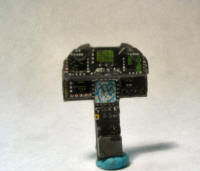 |
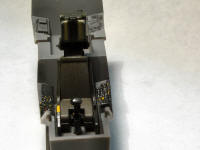 |
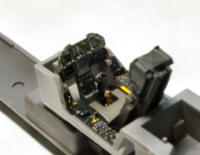 |
 |
 |
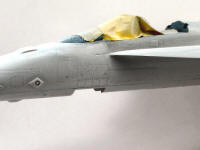 |
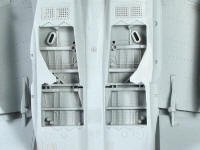 |
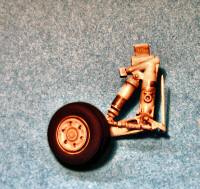 |
 |
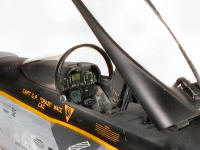 |
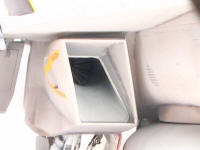 |
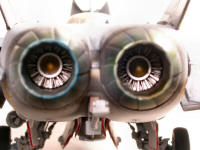 |
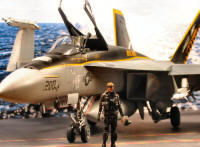 |
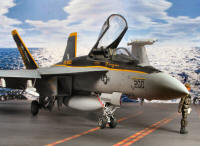 |
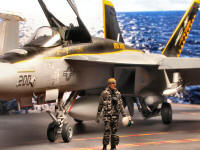 |
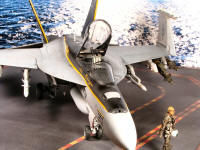 |
|
Information, images, and all other items placed electronically on this site are the intellectual property of IPMS/USA ®. |
|